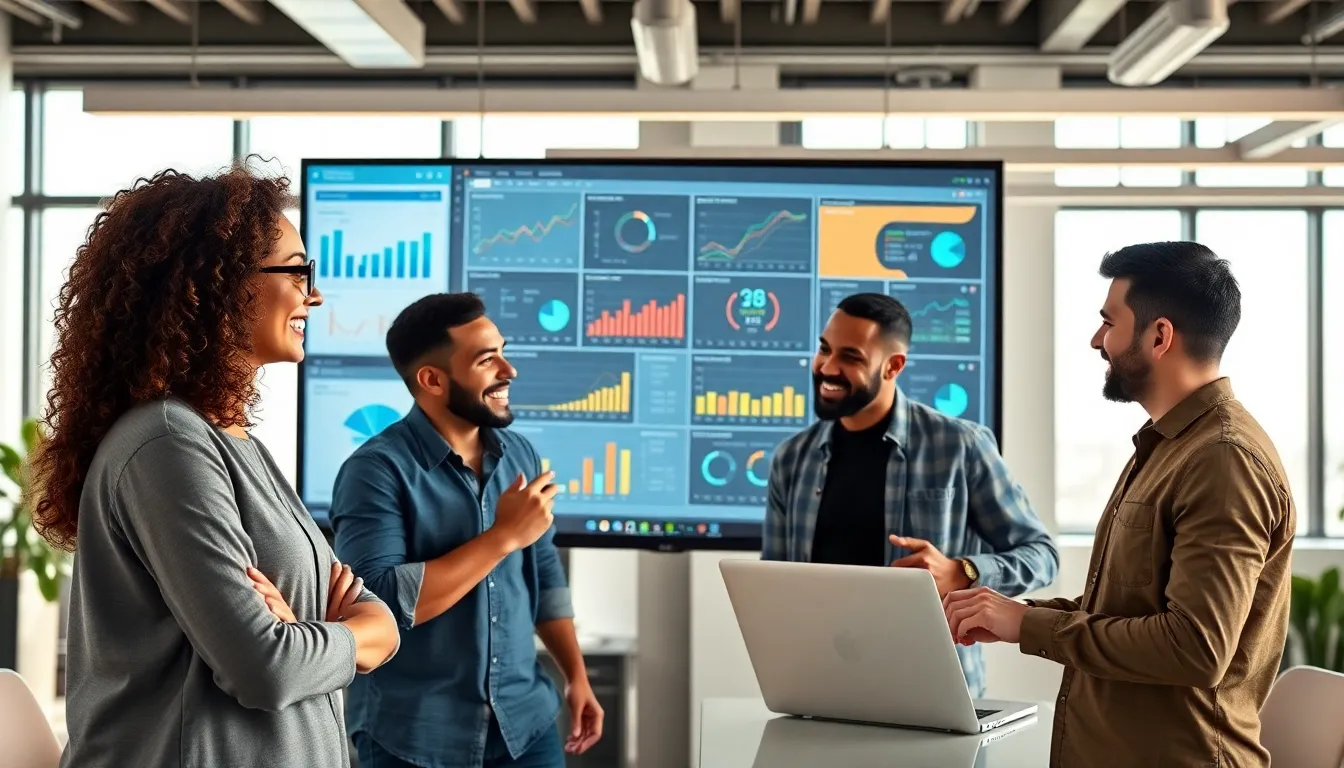As a marketing professional, I’ve seen firsthand how promotion can make or break a brand’s success. Promotion is a vital marketing function that bridges the gap between products and potential customers, creating awareness and driving engagement in today’s competitive marketplace.
I’ve discovered that effective promotional strategies go far beyond simple advertising. They encompass a complex mix of activities including public relations, sales promotions, personal selling, and digital marketing efforts. Together, these elements work to communicate value, build relationships with customers, and ultimately drive sales. Through my years of experience, I’ve learned that successful promotion isn’t just about pushing products – it’s about creating meaningful connections that resonate with target audiences at the right time and place.
Table of Contents
ToggleKey Takeaways
- Promotion is a crucial marketing function that combines advertising, public relations, sales promotions, and digital marketing to create meaningful connections between brands and customers
- The marketing mix (4P’s) integrates promotion with product, price, and place, where promotion serves as the primary communication channel to convey value propositions
- Effective promotional strategies focus on three main objectives: building brand awareness, driving customer engagement, and generating sales through various incentives
- A successful promotional strategy requires careful audience analysis, strategic budget allocation across different channels, and consistent content planning aligned with target demographics
- Both traditional (TV, print, radio) and digital (social media, email, content marketing) promotional tools are essential for maximizing reach and impact in modern marketing
- Measuring promotional success relies on key performance indicators (KPIs) like conversion rates, ROI, customer acquisition costs, and brand awareness metrics through analytics tools
Understanding Promotion in the Marketing Mix
Promotion occupies a vital position in the marketing mix as the communication channel between a brand and its target market. It transforms product features into compelling value propositions that resonate with potential customers.
The Four P’s and Promotion’s Place
The marketing mix contains four essential components: Product, Price, Place and Promotion. Promotion amplifies the other three P’s by:
- Creating awareness about product features through targeted advertising campaigns
- Communicating price points through sales promotions and special offers
- Supporting distribution channels with point-of-purchase displays
- Integrating digital platforms to enhance brand visibility across multiple touchpoints
| Marketing Mix Component | Primary Function | Promotional Role |
|---|---|---|
| Product | Core offering | Communicates benefits |
| Price | Value exchange | Highlights deals |
| Place | Availability | Supports distribution |
| Promotion | Communication | Drives engagement |
- Advertising
- Paid media placements
- Digital display ads
- Television commercials
- Print advertisements
- Public Relations
- Press releases
- Media relations
- Community engagement
- Crisis management
- Sales Promotion
- Limited-time discounts
- Loyalty programs
- Sampling campaigns
- Bundle offers
- Personal Selling
- Face-to-face interactions
- Sales presentations
- Product demonstrations
- Customer consultations
- Direct Marketing
- Email campaigns
- Social media marketing
- Mobile messaging
- Targeted digital content
Key Objectives of Marketing Promotion

Marketing promotion pursues specific measurable goals that align with broader business objectives. Here’s an analysis of three primary promotional objectives that drive marketing success.
Building Brand Awareness
Brand awareness promotion focuses on establishing strong market recognition through strategic communication channels. Digital advertising platforms like Facebook Instagram reach 3.7 billion active users monthly, creating opportunities for enhanced visibility. Companies achieve recognition through:
- Creating distinctive visual identities with logos colors brand elements
- Implementing consistent messaging across multiple platforms
- Developing memorable taglines slogans brand stories
- Maintaining regular social media presence with branded content
- Utilizing targeted advertising to reach specific demographics
Driving Customer Engagement
Customer engagement initiatives create meaningful interactions between brands their target audiences. Social media engagement rates average 4.25% across platforms demonstrating the impact of interactive promotion. Key engagement strategies include:
- Organizing interactive social media campaigns contests polls
- Creating valuable content through blogs videos podcasts
- Responding promptly to customer inquiries feedback
- Implementing loyalty programs rewards systems
- Hosting virtual in-person events community activities
- Offering time-sensitive discounts special deals
- Creating bundle packages volume incentives
- Implementing seasonal promotions holiday offers
- Utilizing cross-selling upselling techniques
- Developing referral programs affiliate marketing
Essential Promotional Tools and Techniques

Promotional tools and techniques form the backbone of effective marketing campaigns, encompassing both traditional and digital channels to maximize reach and impact.
Traditional Advertising Methods
Television commercials deliver high-impact visual messages to mass audiences through 15-30 second spots during prime-time programming. Print advertisements in newspapers reach 124 million U.S. readers monthly through full-page displays product features. Radio spots target commuter audiences through 60-second commercial breaks during peak drive times. Billboard advertising creates 24/7 brand visibility through strategic placement along high-traffic highways expressways.
Digital Marketing Channels
Social media platforms like Instagram Facebook generate 4.8 billion monthly active users through targeted sponsored posts product demonstrations. Email marketing campaigns achieve 40% open rates through personalized content exclusive offers to subscribed customers. Search engine marketing delivers qualified leads through strategic keyword bidding Google Ads campaigns. Content marketing blogs attract 77% of internet users through informative articles industry insights expertise sharing.
Sales Promotion Activities
Limited-time discounts boost sales by 73% through flash sales seasonal promotions clearance events. Buy-one-get-one offers increase transaction values through bundled products complementary items package deals. Loyalty programs retain 82% of customers through points-based rewards exclusive member benefits tiered incentives. Product sampling generates 35% conversion rates through free trials demonstration booths in-store tastings.
| Promotional Channel | Average ROI | Reach Potential |
|---|---|---|
| TV Advertising | 300% | 89% of households |
| Social Media | 95% | 4.8B users |
| Email Marketing | 4200% | 4B users |
| Loyalty Programs | 507% | 82% retention |
Developing an Effective Promotional Strategy

A successful promotional strategy requires careful planning, precise execution and consistent measurement of outcomes. Here’s a systematic approach to developing promotional strategies that maximize impact and deliver measurable results.
Target Audience Analysis
Target audience analysis forms the foundation of promotional strategy development through data-driven customer segmentation. I segment audiences based on demographic factors (age, income, location), psychographic elements (interests, values, lifestyle) and behavioral patterns (purchase history, brand interactions). Key metrics for audience analysis include:
| Metric Type | Key Indicators | Measurement Tools |
|---|---|---|
| Demographics | Age, Income, Location | Census Data, CRM Systems |
| Psychographics | Values, Interests, Lifestyle | Surveys, Social Media Analytics |
| Behavior | Purchase History, Website Activity | Google Analytics, Sales Data |
Budget Allocation and ROI
Budget allocation requires strategic distribution of resources across promotional channels based on performance metrics. I allocate promotional budgets using the following framework:
- Digital Marketing: 40-50% (social media, email, content marketing)
- Traditional Advertising: 20-30% (print, TV, radio)
- Sales Promotions: 15-20% (discounts, loyalty programs)
- Public Relations: 10-15% (media relations, events)
| Channel | Average ROI | Investment Range |
|---|---|---|
| Email Marketing | 4200% | $9-$1000/month |
| Social Media | 95% | $200-$2000/month |
| Content Marketing | 300% | $500-$5000/month |
| Traditional Ads | 160% | $1000-$10000/month |
- Content Calendar Planning: Map key promotional messages to specific dates
- Channel-Specific Formats:
- Social Media: 80-character headlines
- Email: Subject lines under 50 characters
- Blog Posts: 1500-2000 word articles
- Timing Optimization:
- Social Posts: 1-3 PM weekdays
- Email Campaigns: 10 AM Tuesday-Thursday
- Blog Content: Early morning releases
| Content Type | Optimal Length | Best Posting Time |
|---|---|---|
| Social Posts | 80 characters | 1-3 PM |
| Emails | 50-125 words | 10 AM |
| Blog Articles | 1500-2000 words | 6-8 AM |
Measuring Promotional Success
Promotional success measurement relies on specific metrics that track performance across various marketing channels. These measurements provide actionable insights for optimizing promotional strategies and maximizing return on investment.
Key Performance Indicators
Key Performance Indicators (KPIs) quantify the effectiveness of promotional activities through measurable values. Here are essential KPIs for promotional success:
- Conversion Rate: Percentage of audience members who complete desired actions (purchases, sign-ups, downloads)
- Return on Investment (ROI): Revenue generated compared to promotional spending
- Customer Acquisition Cost (CAC): Total cost to acquire one new customer
- Customer Lifetime Value (CLV): Projected revenue from a customer throughout the business relationship
- Brand Awareness Metrics: Social media mentions, branded search volume, website traffic
| KPI Type | Average Benchmark | Measurement Frequency |
|---|---|---|
| Conversion Rate | 2.35% | Daily/Weekly |
| ROI | 5:1 | Monthly |
| CAC | $200-$300 | Quarterly |
| CLV | $1,000-$5,000 | Annually |
Analytics and Tracking Methods
Digital analytics tools capture promotional performance data across multiple channels:
Web Analytics
- Google Analytics for website traffic patterns
- Heat mapping tools for user behavior analysis
- Conversion tracking pixels for purchase monitoring
Social Media Analytics
- Platform-specific insights (Facebook Insights, Twitter Analytics)
- Engagement rate tracking
- Audience growth metrics
- Open rates
- Click-through rates
- List growth rate
| Analytics Tool | Primary Metrics | Data Update Frequency |
|---|---|---|
| Google Analytics | Sessions, Pageviews | Real-time |
| Social Media | Engagement, Reach | Daily |
| Email Platforms | Opens, Clicks | Per Campaign |
I’ve demonstrated how promotion stands as a cornerstone of successful marketing strategies. Through strategic integration of various promotional tools businesses can create meaningful connections with their target audience and drive measurable results.
The future of promotional marketing lies in the seamless blend of traditional and digital approaches backed by data-driven decision-making. I believe that businesses that master this balance while maintaining authentic customer relationships will achieve sustainable growth and market leadership.
Remember that effective promotion isn’t just about selling – it’s about creating value communicating benefits and building lasting relationships with customers. By implementing these promotional strategies and regularly measuring their effectiveness you’ll be well-equipped to achieve your marketing objectives.



